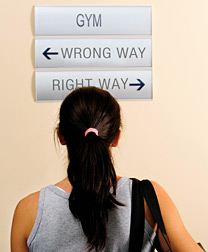Exercise mistakes and how to avoid them, new information from ACE
SAN DIEGO, March 28, 2012 /PRNewswire/ — The countdown to summer has begun, and many are flocking to the gym to get back into bathing suit shape. The American Council on Exercise (ACE) reminds excercise enthusiasts of the importance of safety when starting a new fitness program or ramping up a workout regimen. To help fitness seekers workout safely and efficiently, ACE has released its list of the top three most common mistakes, and how to avoid them. ACE is America’s leading authority on fitness and the world’s largest nonprofit fitness and personal trainer certification, continuing education and training organization.
“As America’s Workout Watchdog, at ACE we are constantly evaluating the latest fitness trends, techniques and routines to determine both the benefits and dangers presented to fitness seekers,” said ACE exercise physiologist, Jessica Matthews. “While these three training modalities are highly effective when done properly, using incorrect form can increase risk of injury. For the most effective and safe workout, we recommend enlisting the aid of a certified personal trainer, who can provide guidance on how to be safe while getting the most out of a workout.”
The following are the top three errors most commonly made with popular workout trends, and tips from Matthews on how to correct these mistakes:
1. Plyometrics: Quick, powerful movements, known as plyometrics, include exercises such as depth jumps, multidirectional drills, and cone jumps, and are designed to increase muscular power and explosiveness. Appropriate strength, flexibility and postural mechanics are necessary in order to avoid injury. Incorrectly landing on the heel or the ball of the foot, however, can increase impacting forces and make participants prone to injury.
How to correct: Master the art of landing correctly, before moving into more advanced moves like full jumps and hops. Focus on landing softly on the mid-foot and then roll forward to push off the ball of the foot – avoiding excessive side-to-side motion at the knee in the process. To further reduce the risk of injury, it is important to complete adynamic warm-up before performing plyometric exercises.
2. Kettlebells: Research confirms thatkettlebell workouts are an extremely effective form of training that can be performed in a relatively short period of time. The problem lies in that many people who use kettlebells do not understand the proper mechanics for the exercises. For example, many incorrectly perceive the kettlebell single arm swing as a shoulder exercise when, it should be working the core.
How to correct: When performing the kettlebell single arm swing, avoid lifting with the back or the shoulders. Like in many kettlebell exercises, the hips should always drive the movement. To execute this movement correctly, contract the abdominal muscles and hinge at the hips. While exhaling, initiate an explosive upward movement to swing the kettlebell upward coming to a standing position. The momentum generated through the lower body should allow the arm to become parallel with the floor with neutral alignment maintained through the wrists. If it is too difficult to achieve the desired arm position, attempt to generate more power from the lower body by thrusting harder with the gluteal muscles from the lowered position.
3. High-Intensity Interval Training (HIIT): HIIT is being used by exercise enthusiasts to add new challenges and variety to workouts. It is a cardiorespiratory training technique that increases the intensity of a workout by alternating between brief speed and recovery intervals to maximize training sessions in a short amount of time. Carelessly overlooking the active recovery intervals that are integral to HIIT is what can make fitness fans more prone to injury.
How to correct: While there isn’t one single best way to structure sessions, when getting started with HIIT after completing a five minute warm-up, begin with a 1:2 or 1:3 ratio of speed intervals to active recovery intervals. This means one minute of speed work to every two or three minutes of active recovery. Avoid the temptation to shorten the recovery intervals, or to let the recovery periods be less than active. These recovery intervals are when the body produces more energy for the next bout of high-intensity exercise and also removes metabolic waste from the muscles. Remember, active recovery periods should always be as long – if not longer – than the high-intensity intervals. In terms of perceived exertion, high-intensity intervals should be about a seven or higher (on a scale of 0-10) while active recovery intervals should be at about a four or five.
For more workout recommendations, fitness technique tips and expert advice, please visit www.acefitness.org.
About ACEThe American Council on Exercise (ACE), America’s premier fitness and personal trainer certification, continuing education, and training organization, is a nonprofit organization dedicated to promoting the benefits of physical activity and protecting Americans against unsafe and ineffective fitness products and instruction. ACE sponsors university-based fitness and exercise science research studies and is the world’s largest nonprofit fitness certifying organization. For more information on ACE and its programs, call (800) 825-3636 or visit the ACE website at www.acefitness.org. AMERICAN COUNCIL ON EXERCISE, ACE and the ACE logos are Registered Trademarks of the American Council on Exercise.
SOURCE American Council on Exercise
Performance Edge Chiropractic, P.C.7112 Ave U
Brooklyn, NY 11234
(917)-309-5464
DrBaio@PEChiro.com
PEChiro.com





No comments:
Post a Comment